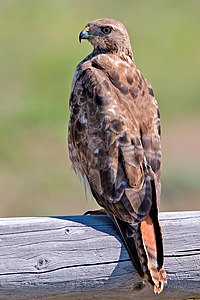
Photo from wikipedia
Escape strategies of animals are economic decisions, expected to vary as a function of both intrinsic (e.g., performance ability) and extrinsic factors (e.g., level of threat and microhabitat). Anthropogenic disturbance,… Click to show full abstract
Escape strategies of animals are economic decisions, expected to vary as a function of both intrinsic (e.g., performance ability) and extrinsic factors (e.g., level of threat and microhabitat). Anthropogenic disturbance, especially urbanization, changes a range of environmental factors including habitat characteristics and predation risk. As a consequence of differences in microhabitat structure and repeated exposure to anthropogenic disturbance, we hypothesize that animals in urban environments will be less risk averse than those in rural environments. Here, we examined the importance of extrinsic and intrinsic factors to understand the escape strategies of Psammophilus dorsalis across an urban-rural gradient. First, urban lizards used lower perches and chose refuges that were closer to their perches compared to rural lizards. Flight initiation distance (FID) of urban lizards in the field was shorter than that of rural lizards, but only for males. In response to a second attack, only rural males decreased their FIDs, whereas urban males showed low and invariable FIDs. Laboratory measures of sprint performance showed expected differences between the sexes, but no significant difference between urban and rural populations. Unlike the strong differences between males across habitats, escape strategies of females were similar in urban and rural areas, most likely because females generally rely on crypsis to minimize predation risk and are resistant to flee when approached. In sum, urban lizards have access to a more complex structural environment, with greater perch and refuge options, and have habituated to non-lethal anthropogenic disturbance. These extrinsic and intrinsic factors combine to result in lower risk aversion and may explain the ability to tolerate urban environments.Significance statementRapid urbanization is at its peak globally, and many animals are forced to adjust to the associated environmental changes or face local extinction. Some species, however, seem to persist in urban areas, and we hypothesize that they behaviorally respond by being less risk averse. We used a multivariate approach to understand the escape strategies of the peninsula rock agama across an urban-rural gradient. Lizards in urban areas use a more complex structural environment, with greater perch and refuge options, compared to rural lizards. Urban lizards also allow closer approaches. Because of the differences in body coloration and size, escape strategies of females were less affected by urbanization as they use crypsis to minimize predation risk. All these extrinsic and intrinsic factors combine to result in lower risk aversion by urban lizards and may explain their tolerance of human altered environments.
Journal Title: Behavioral Ecology and Sociobiology
Year Published: 2017
Link to full text (if available)
Share on Social Media: Sign Up to like & get
recommendations!